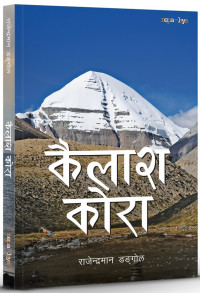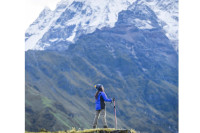Travel
Welcome to the Far West. Here are five things to do in Khaptad.
Although all four neighbouring district can lead to Khaptad, the two easiest ways to reach there are from Doti and Bajhang districts. From Doti, a bus or jeep can take you to Jhigrana, at the foothills of Khaptad. From there, you can get to Khaptad on foot or on a horse.
Basant Pratap Singh
In the Sudurpaschim, there is a place, they say, where horses run wild across fields of impossible green. This is a place of unearthly, unparalleled beauty—the abode of the gods, if any such space existed on earth.
At the confluence of four districts—Bajhang, Bajura, Doti and Achham—lies Khaptad, a mystical place of ethereal beauty, home to countless Hindu shrines and believed to be where the Khaptad Baba achieved enlightenment after meditating for 50 years.
Although all four neighbouring district can lead to Khaptad, the two easiest ways to reach there are from Doti and Bajhang districts. From Doti, a bus or jeep can take you to Jhigrana, at the foothills of Khaptad. From there, you can get to Khaptad on foot or on a horse.
Similarly, from Bajhang, a bus or jeep can take you to Meltadi of Khaptad Channa Rural Municipality. After a three-hour walk from Meltadi, you reach Ghodadauna Patan of Khaptad National Park.
As a pristine land untouched by tourists, there are many off-the-beaten-path activities that can be done in Khaptad. Here’s a list of five things you can do there:
Go on a pilgrimage
There are religious shrines and places of pilgrimage all over Khaptad. There’s the afore-mentioned Khaptad Baba ashram, built by the former king of Bajhang, Ram Jung Bahadur Singh, which stands at a height of 3,300 metres in the Ghodadauna area. Legend holds that the Khaptad Baba was an allopathy doctor who, after failing to treat a patient, turned to ayurveda, yoga and meditation. In Khaptad, he is supposed to have authored a number of books, including Bichar bigyan (philosophical science), Swasthya bigyan (health science). The materials used by Khaptad Baba and his books are still preserved in this ashram.
Among other places of religious import is Siddhibinayak a shrine at 3,500 metres that acts as a natural observatory; the Sahas-tralinga, a shrine designated by a huge boulder with three cone-shaped peaks on top that signify Shiva, Parvati and Ganesh; and the Khaduli-Duduli Mai, where a holy pyre burns and three dharmasalas provide a rest stop for pilgrims.
Immerse yourself in natural splendour
The Khaptad Daha is a mysterious lake whose source and outlet are still unknown. A fascinating side to this lake is that it is divided into two parts on the basis of its water—one being limpid, white water while the other half is murky, brown water.

To the north of this lake is the Jagannath Temple, built during the 13th century, according to Bishnu Prasad Khatri, a researcher and former government secretary. This temple is unique for having a Sarki priest, when Sarkis were considered untouchable in the strict Hindu caste system.
Another scenic spot in Khaptad is Trivenidham, a confluence of three rivers that are regarded as representations of the Ganga, Jamuna and Saraswoti. Dawn and dusk at Trivenidham are mesmerising, as deer, boar, ghoral and lophophorus visit this confluence to quench their thirst.
Surround yourself of its flora and fauna
Spread out over an area of 225 sq km, Khaptad National Park is one of Nepal’s best-kept secrets. Ranging from 2,400 metres to 3,700 metres above sea level, there are 22 grasslands and 53 lakes in the park, estimated to host 567 plant species, with 135 different species of flowers, including four native, along with 30 species of wildlife. Of the 700 medicinal plants available in Nepal, 224 different herbs can be found here. This region is also home to 270 bird species. This is the only national park where the bagbutte ningalo, a unique type of bamboo, is found.
There are over 30 species of wildlife that live in 12 dens of the national park. Nepal’s national bird, the danfe, is among the species found in the national park that is regarded as endangered. Similarly, endangered mammals, such as the red panda, musk deer, clouded leopard, and wolf, black bear, wild boar and antelope are also found here.
Although this region is covered in snow for around four months in the year, it is also known for its variety of flowers. According to Khaptad National Park, around 135 species of flowers blossom in the region. There are 14 species of rhododendron alone. Due to its wide variety of flowers, the region also hosts 115 species of butterflies.

Go on a hike
Khaptad is ideal for a short hike or a more rigorous trek. It takes about 3-7 hours from the four neighbouring districts to reach the Nepal Army barracks in the middle of the national park. The barracks also has a guesthouse that provides room and board facilities. From there, the famed Khaptad Baba’s ashram is only a half-hour walk away.
Throughout the hiking trail to the ashram, there is scenic panoramic views of the Himalayas. The scenery of mountains such as Saipal, Aapi, Gurla Mandhata, Madugra, and Ingaldwar follow wherever you go around the region. One can also get a closer view of the mountains from Ghodadauna meadow and Danphekot of the national park.
From the ashram, a 30-minute downhill walk brings you to Triveni, another pilgrimage where visitors take holy dips to relieve themselves of sin. Another three-hour walk leads to Sahasraling, where the Siddhibinayak temple is situated. One more must-visitdestination in Khaptad is Nag Dhunga. While some ski here in the winter, a three-hour walk in the summer through lush green pastures affords distant views of the Saipal mountain.

Taste the local culture and cuisine
During the Dasara festival held in mid-April in Khaptad, people from all around Sudurpaschim come to the region to celebrate in their traditional attire, showcasing their diverse culture. Other festivals such as Deuda, Chutkila and Mangal also reflect the region’s unique culture.
The famous Marsi rice also comes from this region. Meltadi and Daru villages in Channa Rural Municipality are famous for their organic Marsi rice which can be served alongside nettle, dhakaya, jarko (lentils), organic potato, choto (a special kind of radish-like vegetable found in the Himalayas), buckwheat, bethe (local spinach) and bhaang (marijuana seed) chutney.
The yoghurt from Khaptad too is known for its unique flavour. Local farmers claim that it has inebriating properties. They attribute this to the cattle grazing on herbs with hallucinogenic properties. Khaptad’s buttermilk and ghee are also sought-after dairy products.
Some of the unique cuisines of the Sudurpaschim province include mana (paddy), batuk, chukani and gharya bread that are served in local hotels in and around Khaptad.





 16.12°C Kathmandu
16.12°C Kathmandu

















